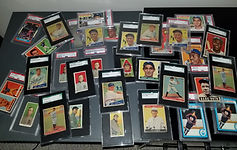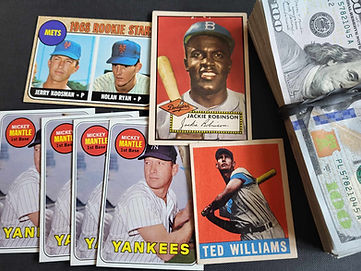
We Buy Vintage Baseball Cards: Sell Your Collection For Top Dollar Today
How To Easily Sell Your Vintage Baseball Cards
Sell Your Cards In 3 Simple Steps
Turn Your Vintage Baseball Cards Into Cash Today
Throwback Sports Cards is THE PLACE to sell vintage baseball cards
Throwback Sports Cards is private collecting company specializing in buying 1900-1969 vintage sports cards. Whether it's your childhood collection, cards you inherited from a family member, or a lifetime collection, we want to hear about it! Each collection has a history, and we want to hear the story.

Describe Your Collection
Send us a list & pictures of the highlights of your collection. Be sure to note any complete sets,"Star" cards, rookies, and unopened boxes. Also note the years and approximate number of cards.
Free Appraisal & Offer
We review and catalog each card in the collection, noting condition and value. A free appraisal and fair offer is then presented to the seller.
Get Paid
After the offer is accepted, the seller selects their preferred payment method. This includes cash, check, Paypal, or Zelle. We strive for hassle free deals with lightning fast payments.


Contact Us
Do you have questions about the value of your baseball card collection or the selling process? Reach out today and we will get back to you as quickly as possible.
(734) 931-0461
Straight Forward Selling Process
Honest Appraisals

Top $ Paid
Lightning Fast Payment
What We Buy
Throwback Sports Cards specializes in buying 1900-1969 sports and non-sports cards including:
-
Full Collections
-
Complete Sets
-
Hall of Famers
-
Rookies
-
Topps, Bowman, Goudey, Leaf, Tobacco, & More
-
Unopened Boxes
-
Raw and Graded (PSA, SGC, BVG)
Players of Interest: Babe Ruth, Ty Cobb, Lou Gehrig, Mickey Mantle, Hank Aaron, Willie Mays, Jackie Robinson

Ways To Sell Your Cards
Schedule Appointment
Meet At Convenient Location
Ship Collection To Us
Schedule In-Home Evaluation
-
How Do I Get Paid?We offer multiple options for payment including cash, check, Paypal, and Zelle. Once a deal is struck, we offer lightning fast payment.
-
Can I Trust Selling To Throwback Sports Cards?Throwback Sports Cards is a private collecting company with over 20 years in the hobby. Our reputation of honesty and integrity is evident through our 5 star Google rating. We believe in full transparency with the goal of making sure our clients have a positive selling experience and are comfortable completing a deal with us.
-
How Much Are My Vintage Sports Cards Worth And How Is Value Determined?The value of sports cards depend on many factors including the player, set, year, condition, and rarity. We base prices off the current market value. Check out our price guide for help determining the value of you cards.
-
How Do I Sell With Throwback Sports Cards?Reach out to us through our contact form, phone (734-931-0461), or email (info.throwbacksportscards@gmail.com). Include a description/list and pictures of your collection. A free appraisal and offer will be provided. Deals can be completed in person or through the mail.
-
How To Sell My Cards Through The Mail?Selling your cards via mail is easy: Package & ship your collection to us We review and catalog your collection A free appraisal and offer is provided Get paid through your preferred payment method **If for some reason we cannot agree on a deal, we will ship your collection back to you fully insured (we cover shipping costs)
-
How do I sell my vintage baseball cards?Selling your collection is easy. Reach out to us via phone, text, email, or our free appraisal form to get started. After we determine what you have, an offer will be made. When you choose to accept our offer arrangements will be made to complete the deal. Options include mail or meeting in person. We regularly travel to accommodate our clients. Sell your cards today
-
How do I figure out what cards I have?Need help identifying what cards you have? Check out our vintage baseball card database. Included are reviews of popular Topps, Bowman, Leaf, Play Ball, and Goudey sets.
-
How much are my vintage sports cards worth and how is value determined?The value of sports cards depend on many factors including the set/year/players, condition and rarity. We base prices off the current market value. Check out our price guide or free appraisal form for help determine how much your cards are worth.
-
How do I get paid?After a deal is reached we typically pay our clients with cash, PayPal, or check.
-
Why sell your sports cards to Throwback Sports Cards?Throwback Sports Cards is a private collecting company with over 20 years in the hobby. Since we aren't looking to re-sell we can pay more than card shops. It is our promise to give you a fair and honest appraisal so you feel comfortable completing a deal with us.
-
What is Throwback Sports Cards looking to buy?We are looking to buy 1900-1969 baseball, football, hockey, and basketball cards including full collections, complete sets, rookies, Hall of Famers, and unopened boxes. We especially love tobacco cards, Goudey gum cards, and Topps sets from the 1950s
-
How do I get top dollar for my sports card collection?Prior to selling your collection it is best to do some research (years, era, sets, key cards). The more information and pictures which can be provided to us the more we typically can offer. Check out our price guide for more information on vintage card values and key sets/players.
How To Prepare Your Collection To Sell
Create An Inventory List
**Not all this information is required for an appraisal. It helps give us a better idea of what you have. For more information about how to identify the brand, year, and players, click below
Check out our Price Guide and Baseball Card Database for help figuring out what you have
